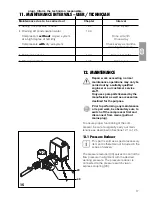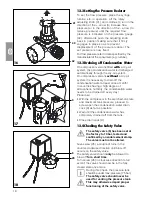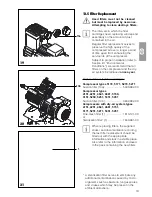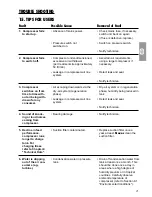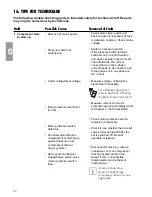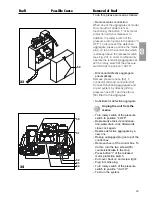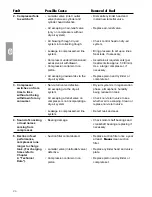
9
6. FUNCTIONAL DESCRIPTION
6.1 Compressor with
Dry-air System
Concise Functional Description:
The compressor aggregat (10a) draws in
atmospheric air which is then compressed
without any contamination by oil.
The compressor feeds the compressed oil-
free air to the dry-air system (2).
The dry-air system removes moisture from the
compressed air.
Now in an dry state, the clean, oil-free air is
made available in the pressure tank (8) to the
consumers (e.g., turbine).
Detailed Functional Description:
•
•
•
•
•
Compressor Set
Atmospheric air is drawn in via the intake
filter (13). The cylinder piston (12) of the
compressor set (10a) then compresses the
air. The inlet valve/outlet valve blocks the
direction of flow so that the compressed air
is forced to the dry-air system (2).
•
Dry-air System
The compressed air is conducted round the
dry-air system via the spiral-shaped cooling
tube (3).
Inside the cooling tube, the compressed,
heated air cools down and a large percentage
of the moisture present in the air is extracted
in the form of condensation water.
This pre-dried air then passes into the
pressure tank (8) via the drier (14), sintered
metal filter (4), fine-mesh or sterilisation filter
(1) and non-return valve (15a).
The non-return valve (15)a serves to prevent
any backflow of the compressed air emerging
from the pressure tank.
Each time the compressor is switched off,
the condensation water is blown into the
water collecting (5) through by means of the
dry-air system and the pressure hoses are
vented on the compressor.
•
•
•
•
•
Regeneration of the Dry-air System
The polyamide band (16) fitted inside the
hygrostat expands due to the presence of
humidity. If the permissible relative humidity
inside the pressure tank (8) is exceeded, the
valve on the hygrostat responds by open-
ing, causing air to flow out of the pressure
tank in the opposite direction. This can be
heard blowing out underneath the dry-air
system (2). In this phase, the system under-
goes a process of regeneration, for which
purpose the compressor must be at a
standstill. This process of regeneration will
continue to repeat itself until the relative
humidity originally set on the hygrostat (16)
is attained.
•
•
•
•
•
Valve Unit with Pressure Switch
Whenever compressed air is withdrawn for a
certain consumer (e. g., turbine), the pressure
inside the tank is reduced. When the minimum
tank pressure set on the pressure switch (11)
is attained, the compressor will be switched
on again via the pressure switch. As soon as
the maximum tank pressure (7.5 bar) set on
the pressure switch is attained (5,5), the
compressor will switch itself off. The maxi-
mum permissible tank pressure of 10 bar is
marked in red on the pressure gauge (7).
The safety relief valve (6) serves to prevent the
maximum permissible tank pressure of
10 bar from being exceeded.
The drain cock (9) is used for draining off
condensation water from the pressure tank,
this being done by opening the valve.
Also refer to Section 12.3 "Draining Off
Condensation Water".
6.2 Compressor without
Dry-air System
•
•
•
•
•
Compressor set
The compressor set (10b) draws in atmos-
pheric air via the suction filter (13) which is
then compressed without any contamination
by oil by means of the cylinder piston. The
inlet valve/outlet valve blocks the direction of
flow so that the compressed air is forced
through the non-return valve (15b) into the
pressure tank (8).
•
Pressure Switch
The compressor set (10b) continues to feed
compressed air until the maximum pressure
preset on the pressure switch (11) is attained
inside the pressure tank (8) and the
compressor set switches itself off.
After the compressor set has switched itself
off, the pressure hoses are vented via vent
valve (17).
•
•
•
•
•
Valve Unit with Pressure Switch
Refer to previous section, "Detailed Functional

















